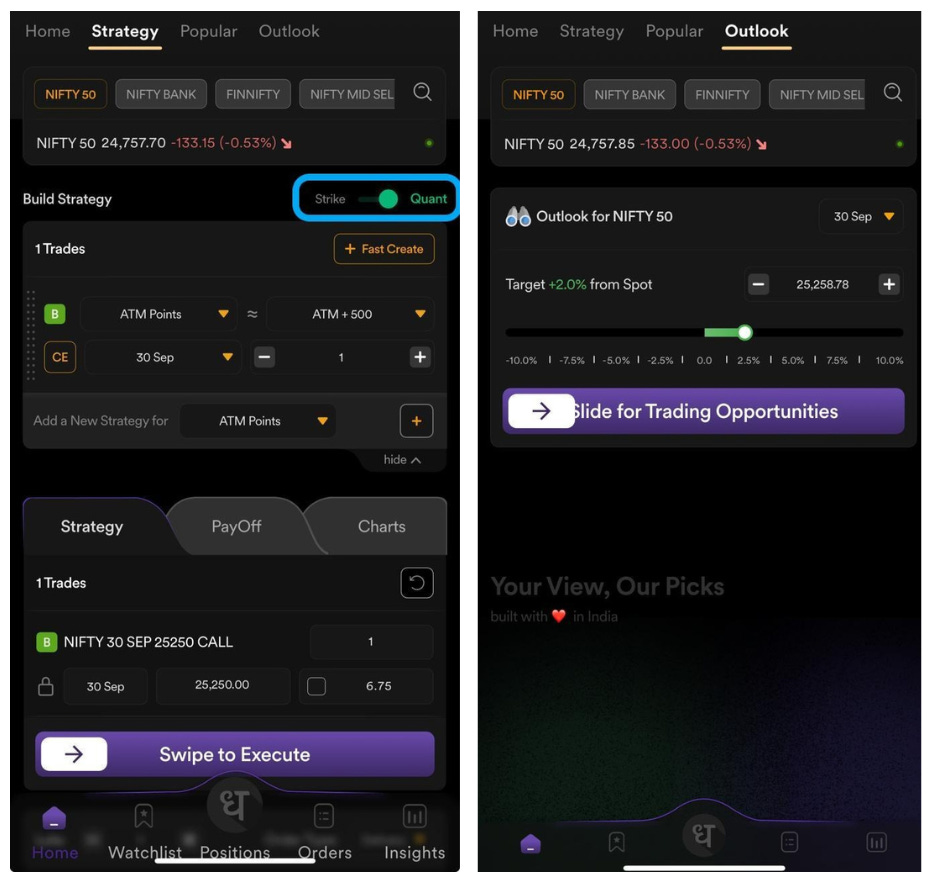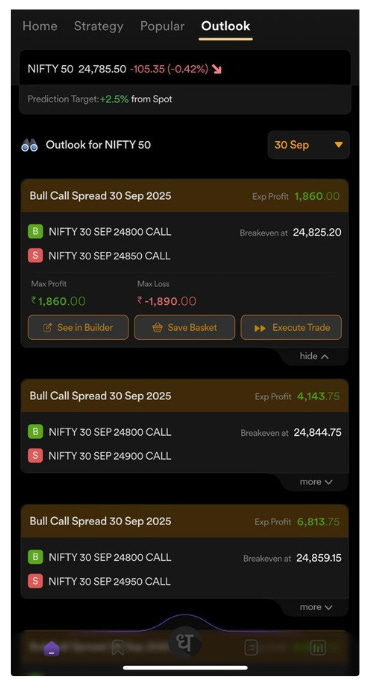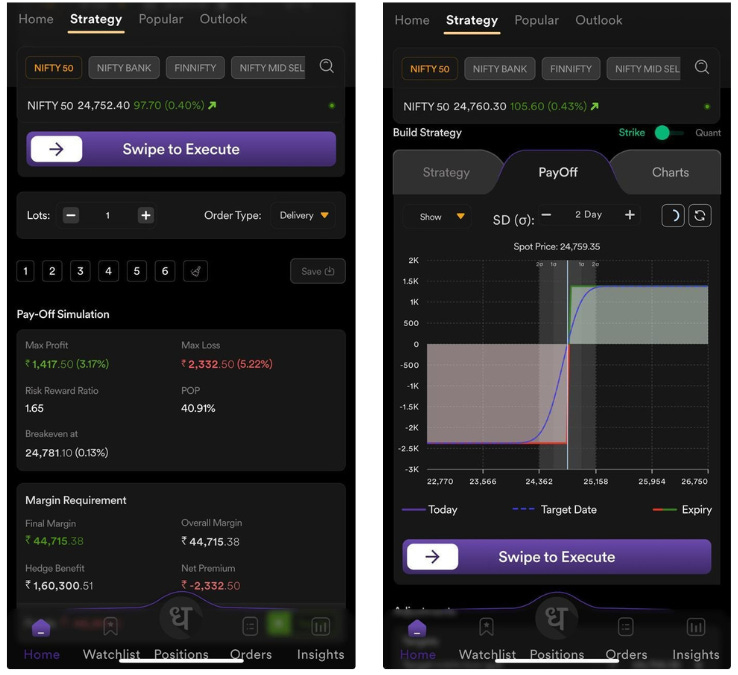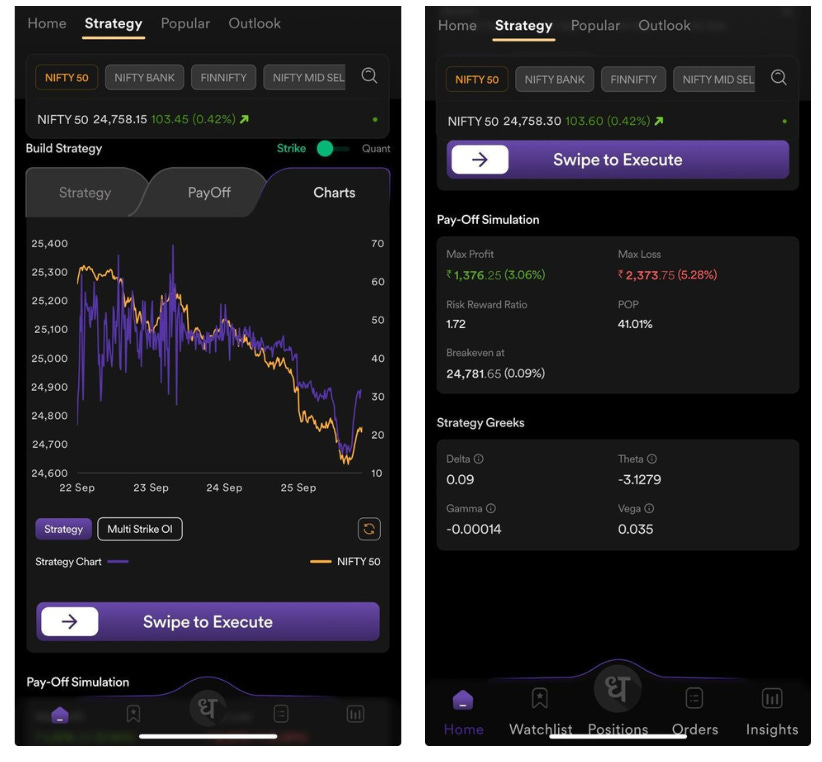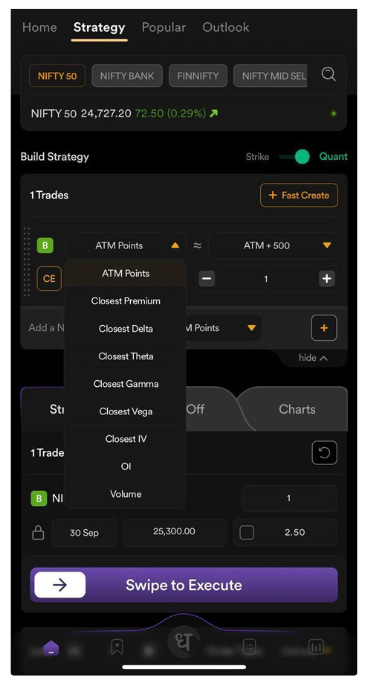Quant Mode: Toggle your way to Auto-pilot
What is Quant Mode on Options Trader by Dhan? It is your way to focus more on strategising and minimising your manual efforts.
You’re about to hit the highway. You’ve got two options: drive old-school, relying on instinct, memory, and the occasional roadside signboard. Or, flip on The Maps. The difference is night and day.
Maps not only show you the way but also traffic (volatility), tolls (premiums), alternate routes (strategies), and an ETA (your expected P&L). Suddenly, you’re not just driving, you’re strategizing.
That’s what Quant Mode is for Traders. With a single toggle, you go from being a driver squinting at blurry signboards (charts, news tips, half-baked opinions) to someone with a bird’s-eye view of the terrain.
It doesn’t remove the uncertainty of the market; it stacks the odds in your favour. You’re no longer guessing, you’re planning, executing, and adjusting like a pro.
Two Ways to Fire Up Quant Mode
Auto-Pilot: You tell it your destination (bullish, bearish, range-bound), and it lays out ready-made routes (strategies) tailored to your view.
The Race Track: You open the hood, tinker with the engine, and design trades catching the nerve of options: Greeks, Open Interest (OI), and Volumes.
Both modes lead you to the same goal: finding opportunities, but they take different routes within the Map of Market: one is “sit back and enjoy the ride,” the other is “hands on the wheel, every turn calibrated.”
Auto-Pilot
Sit back and let the Machine take the Wheel
Trading Like Ordering a Meal
Here’s how it works:
You state your Market Outlook: “I’m bullish,” or “I’m bracing for a fall”.
Slide for Trading Opportunities.
The system instantly generates a menu of strategies across a few primary heads.
Each strategy is served with:
The risk-reward ratio is clearly labelled.
Payoff visuals so you know where profit begins and loss bites.
Explanations that help you pick the one that fits your appetite.
It’s like telling a food app you’re craving Italian. Instead of scrolling endlessly, it presents pizzas, pastas, risottos—all priced, portioned, and reviewed. You just pick what suits your mood and pocket.
Example Scenarios:
Bullish View → Suggestions like Bull Call Spreads (debit strategy, low cost, capped upside), or Bull Put Spreads (credit strategy, with income flavor), or Long Iron Condor / Iron Butterfly, and even Long Straddle/Strangle.
Bearish View → Bear Put Spreads (moderate risk, defined gain), or Bear Call Spreads (selling others’ optimism), or Long Iron Condor / Iron Butterfly, and even Long Straddle/Strangle.
In this mode, you’re basically outsourcing the heavy lifting to the system. It’s like being told: “These are the best dishes for your taste today—pick one”.
Just an example to show that you get to see: Pay-off simulation, Pay-off chart, Strategy Spread chart and the Strategy Greeks.
The Race Track
Trading Like Tuning a Sports Car
This is the playground for tinkerers: the Quant Brain. Here, you’re not just saying “bullish” or “bearish.” You’re building a strategy piece by piece, guided by Greeks, OI, and Volume. This is exactly where the Quant Mode really shines.
ATM and ATM ± Points Selection → At-the-Money is the pivot point of the options chain, where sensitivity to multiple Greeks is at its peak. Looking slightly above or below ATM (say, ±100 or ±200 points) helps balance between aggressiveness and safety. ATM trades are the most responsive, while moving outward reduces sensitivity but also lowers risk.
Closest Premium to a Price → For traders who operate with strict capital discipline. This filter helps you find strategies that fit neatly within a predefined cost range, ensuring you don’t overshoot your budget.
Closest Delta → The choice for directional traders. Delta measures how closely your option position mirrors movements in the underlying. A higher delta means your trade behaves almost like the stock itself; a lower delta gives you more insulation from sharp moves.
Closest Theta → The preferred metric for premium sellers. Theta captures the steady erosion of option value with time causing losses for the buyer, but consistent income for the seller. It’s the quiet background current of the options market that, if harnessed well, can become a reliable yield.
Closest Gamma → Gamma reflects how quickly your delta shifts as the market moves. High gamma means your position reacts faster, which can be rewarding in fast markets but destabilizing if mismanaged. It’s the leverage on your leverage: powerful but demanding respect.
Closest Vega → Vega shows how sensitive your position is to changes in implied volatility. If volatility rises, long Vega positions benefit; if it falls, short Vega positions profit. It’s less about market direction and more about preparing for how stormy or calm the trading climate will be.
Closest IV (Implied Volatility) → Implied volatility is the market’s forecast of future uncertainty. Filtering trades by IV zones lets you decide whether you want to position in low-volatility conditions (with the potential for expansion) or in high-volatility conditions (with the potential for contraction).
Closest OI (1st–5th Highest) → Open Interest points to where traders have already committed capital. High OI strikes often act like magnets or barriers for price action, giving clues about where the broader market is positioned and where liquidity is deepest.
Closest Volume (1st–5th Highest) → Volume highlights where the immediate action is concentrated. High activity levels can indicate zones of short-term speculation or hedging, making them useful for traders looking to ride intraday flows.
Putting it all together
Most traders enter the market like cricketers walking in blindfolded. Quant Mode takes that blindfold off. It becomes your pitch report, your weather radar, and even your opposition analysis rolled into one. It organises the information and tells you which deliveries are likely to swing, which patches might turn, and where the field is most vulnerable.
That’s where the real shift happens. With a single toggle, you go from being a driver squinting at signboards (charts, news tips, half-baked opinions) to someone with a bird’s-eye view of the terrain.
Quant Mode doesn’t remove the uncertainty of the market; it stacks the odds in your favour. You’re no longer guessing, you’re planning, executing, and adjusting like a pro.

